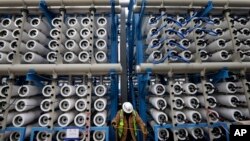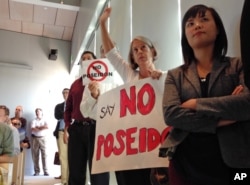North America's largest desalination plant opened earlier this week in Southern California, which has suffered severe drought conditions for the past four years.
The plant in Carlsbad, which has been under construction since 2012, cost $1 billion and will produce 50 million gallons of water per day for roughly 400,000 people in San Diego County.
Supporters consider seawater desalination a partial answer to drought in the U.S. However, opponents say high costs and threats to marine life leave better alternatives, such as recycling and conservation.
Desalination plant
Poseidon Water, which developed and owns the plant, has signed a 30-year agreement with San Diego County Water Authority. The company estimates households in the region will pay an additional $5 per month on their water bill to help offset the cost of the plant.
As big as it is, the Carlsbad plant barely cracks the International Desalination Association's list of 50 largest seawater plants, which are mostly in the Middle East.
The plant uses a technology called reverse osmosis, which uses powerful pumps to shoot ocean water through 2,000 white fiberglass tubes to capture salts. Before that, however, silt and other solids are removed to prevent membranes from clogging.
Peter MacLaggan, Poseidon Water project manager, said, "Every two gallons of seawater that go into the plant, we produce one gallon of fresh water. One gallon of double salty water that goes back to the ocean gets diluted on the way out of the plant so it does not harm the marine environment."
Treated water is pumped uphill on a new 10-mile pipeline to San Diego's existing grid.
The San Diego water agency said the plant will provide about 8 percent of the region's drinking water.
Bob Yamada, water resources director, said desalination "is not going to be a silver bullet that solves all of our problems," but it has better positioned the region for drought.
Opponents argue conservation
Local environmental groups have criticized the plant, claiming it poses risks to the marine environment and the energy involved in the desalination process.
Julia Chun-Heer, a spokeswoman for San Diego County's Surfrider Foundation, an environmental group, said, "This is the most energy-intensive water supply option with the most greenhouse gas emissions ... as opposed to doing things like conserving water ... doing the things that are environmentally beneficial, or reclaiming water that has already been pumped here."
Joe Geever, a consultant to Surfrider Foundation, which unsuccessfully sued Poseidon, echoed Chun-Heer.
Geever said, "There is a lot of waste in the way we use our water. We can get more conservation without any impact on the economy or, really, with some simple changes to human behavior. ... Just change some of our bad habits about the way we waste water."
San Diego began considering desalination in the early 1990s when drought made apparent the region's dependence on water brought hundreds of miles from Northern California and the Colorado River.
Officials picked Carlsbad, a prosperous suburb of 110,000 people, because it could draw water from a power plant next door that uses up to 600 million gallons from the ocean daily to cool turbines.
Huntington Beach plant eyed
Poseidon is pursuing a second, identical-size plant in Huntington Beach, Calif., positioning the Los Angeles suburb as California’s next desalination battleground. The company is seeking a final permit to begin construction next year.
The Carlsbad project is only the nation’s second major seawater plant. The first U.S. foray, in Tampa Bay, Florida, is widely considered a flop.
Tampa, which has half the capacity of Carlsbad, opened in 2007, a decade after it went to bid. Along the way, a key investor declared bankruptcy, its replacement failed to secure financing, and the plant repeatedly failed performance tests.
Some material for this report came from Reuters and AP.













